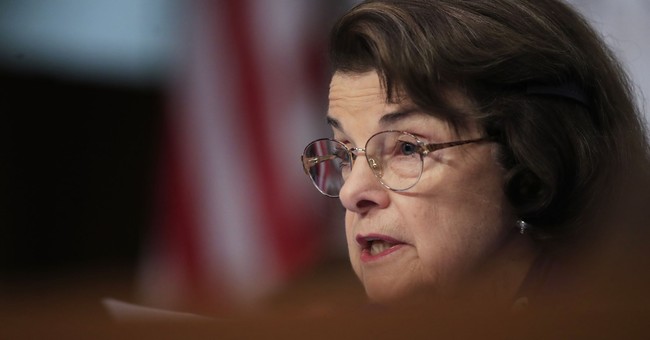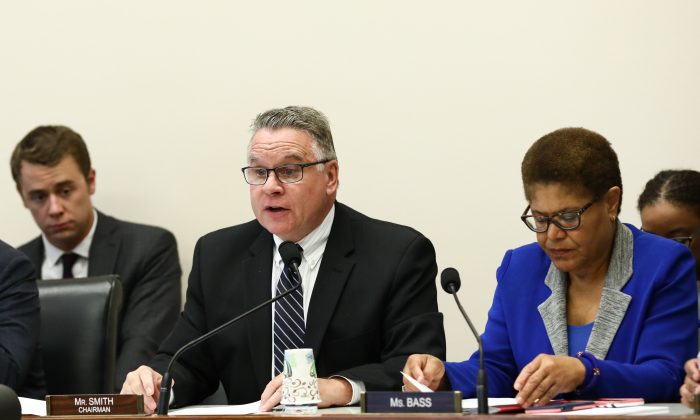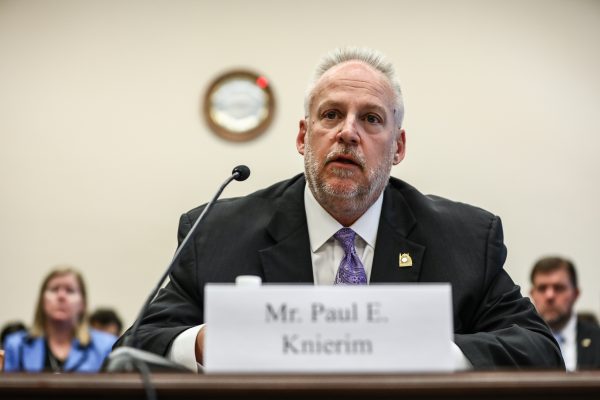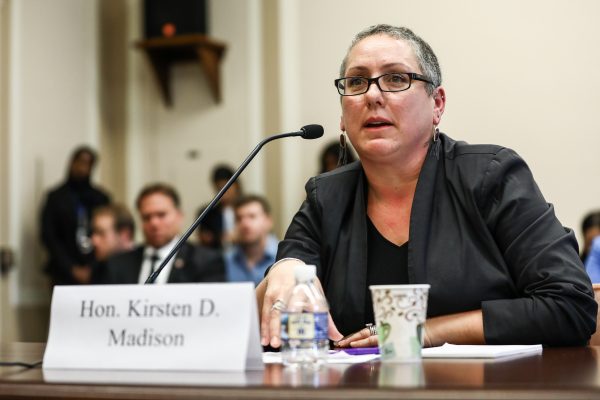SENATOR
DIANNE FEINSTEIN, CROOKED, WAR PROFITEER, PLUNDERER OF THE AMERICAN PEOPLE and
SERVANT of RED CHINA FOR RAW CASH!
IN THE November 2006 election, the voters demanded congressional ethics reform.
And so, the newly appointed chairman of the Senate Rules Committee, Dianne
Feinstein, D-Calif., is now duly in charge of regulating the ethical behavior
of her colleagues. But for many years, Feinstein has been beset by her own
ethical conflict of interest, say congressional ethics experts.
IN THE November 2006 election, the voters demanded congressional ethics reform. And so, the newly appointed chairman of the Senate Rules Committee, Dianne Feinstein, D-Calif., is now duly in charge of regulating the ethical behavior of her colleagues. But for many years, Feinstein has been beset by her own ethical conflict of interest, say congressional ethics experts.
$ERVANT OF RED
CHINA FOR RAW CA$H, $ENATOR FEIN$TEIN’S DRIVER IS A $PY FOR HER CHINE$E PAYMA$TER$!
Feinstein: Kavanaugh Believes Trump Is an 'Oligarch'

One of Democrats' concerns about Supreme Court nominee Brett Kavanaugh is that he would let President Trump skirt above the law. Some of Kavanaugh's past writings show that he believes a sitting president should not be subjected to investigations. That should wait until after he or she leaves office. But, Democrats point out, he had a different opinion when Bill Clinton was president. During the Monica Lewinsky scandal, Kavanaugh was all about pursuing answers about the president's conduct. The senators wanted to know what changed.
What changed, Kavanaugh said, was the September 11 terror attacks. The country was at war and he thought President George W. Bush should be shielded from controversy while trying to perform his duties.
"Seeing President Bush when he came into the Oval Office on September 12, 2001 in the morning," Kavanaugh reflected. "President Bush said this will not happen again. He was of single minded focus every morning for the next seven years."
His answer did not placate Sen. Dianne Feinstein (D-CA). On Sunday, she told an audience at the Year of the Woman luncheon in Santa Barbara that Trump likes to hold himself “above the law,” and Kavanaugh would go right along with it. He believes Trump is an "oligarch."
“The president believes he is above the law," she said. "And this nominee believes this president cannot be investigated, cannot be tried.”
Feinstein added that if moderate Republican Sens. Susan Collins (ME) and Lisa Murkowski (AK) don't come through and vote against the nominee, he will be confirmed.
Other Democrats have pointed out that Kavanaugh once questioned the court ruling in Nixon vs. United States. But, the nominee debunked that theory at last week's hearings too, noting that he has called that court case one of the most important in history.
 As of 2017, California had a homeless population of over 134,000, or one quarter of the nation’s homeless. UCLA researcherWilliam Yu notedthat 26% of California’s homeless are severely mentally ill, 18% are chronic drug abusers, 9% are veterans and 24% are victims of domestic abuse. Orange County Supervisor, Tod Spitzer attributes much of the problem to legislation signed by Governor Jerry Brown over the past few years that markedly decreased the penalties for drug use, possession, and petty crimes, thereby reducing arrests and eliminating mandatory treatment for drug abuse and mental health treatment.
As of 2017, California had a homeless population of over 134,000, or one quarter of the nation’s homeless. UCLA researcherWilliam Yu notedthat 26% of California’s homeless are severely mentally ill, 18% are chronic drug abusers, 9% are veterans and 24% are victims of domestic abuse. Orange County Supervisor, Tod Spitzer attributes much of the problem to legislation signed by Governor Jerry Brown over the past few years that markedly decreased the penalties for drug use, possession, and petty crimes, thereby reducing arrests and eliminating mandatory treatment for drug abuse and mental health treatment.
The Once 'Golden State' Is Badly Tarnished
With crime soaring, rampant homelessness, sanctuary state status attracting the highest illegal immigrant population in the country and its “worst state in the U.S. to do business” ranking for more than a decade, California and its expansive, debt-ridden, progressive government is devolving into a third-world country. In cities such as San Francisco, public defecation is legal, drug use is flagrant, and tent cities are designated biohazards. In once pristine San Diego, contractors have been spraying down homeless encampments with household bleach to stave off a hepatitis A epidemic. The so-called “Golden State,” which now has the highest poverty rate in the nation, is tarnished beyond recognition with such serious problems that the sublime climate and striking coastline may no longer be enough to sustain its reputation and cachet. With laws that benefit criminals and illegals, big government that endeavors to control every aspect of residents’ lives from plastic bags to straws; sanctioned street, tent, and vehicle dwelling; and an unaffordable overhyped bullet train boondoggle that will cost taxpayers almost $100 billion, California is headed for economic disaster.
BLOG: SEN. DIANNE FEINSTEIN'S HUSBAND RICHARD BLUM IS ONE OF THE PARASITES FEEDING ON THE BULLET TRAIN. HE FEEDS ON ANYTHING A BRIBE OR FEINSTEIN CAN VOTE ON.
BLOG: SEN. DIANNE FEINSTEIN'S HUSBAND RICHARD BLUM IS ONE OF THE PARASITES FEEDING ON THE BULLET TRAIN. HE FEEDS ON ANYTHING A BRIBE OR FEINSTEIN CAN VOTE ON.
Rising Crime
In the past few years, California has instituted criminal justice reform legislation and initiatives, ostensibly to reduce budget expenditures and prison overcrowding, which has led invariably to the release of more criminals into the state’s population.
- Proposition 47, a referendum passed in 2014, reclassified certain drug possession felonies to misdemeanors and required misdemeanor sentencing for theft when the amount involved is $950 or less. Drug possession for personal use is now considered a misdemeanor.
- Proposition 57, a statewide ballot proposition passed in 2016, changed parole policies for those convicted of nonviolent felonies. But the proposition failed to define “nonviolent crimes”. The result was that those committing “nonviolent” crimes such as rape of an unconscious or intoxicated person, assault of a police office, domestic violence, hostage taking, drive-by shootings, and human trafficking of a child became eligible for early parole based on a paper review in lieu of a parole hearing.
- Assembly Bill 1448 and Assembly Bill 1308 allow for the early release of prisoners who are 60 years or older who have served at least 25 years of their sentence and prisoners who committed crimes at least 25 years or younger who have served at least 15 years, respectively. Both were signed into law by Governor Jerry Brown in 2017.
- In June this year, Gov. Brown signed into law AB 1810, that gives defendants a chance to have their charges dismissed and evidence of their arrest erased from the record if they can convince a judge that they suffer from a treatable mental disorder. Such defendants could be offered a pretrial diversion of two years to undergo mental health treatment.
As may have been expected with lenient policies, violent crime and property crime rates in the state increased and will mostly likely soar in the aftermath of some of the newly implemented measures. An FBI study of crime rates from 2014 to 2015 found that 48 California cities saw overall increases with 24 experiencing increases in the double digits for property crime, an increase directly attributable to Prop. 47, according to Marc Debbaudt, past president of the Association of Los Angeles Deputy District Attorneys.
Homelessness
 As of 2017, California had a homeless population of over 134,000, or one quarter of the nation’s homeless. UCLA researcherWilliam Yu notedthat 26% of California’s homeless are severely mentally ill, 18% are chronic drug abusers, 9% are veterans and 24% are victims of domestic abuse. Orange County Supervisor, Tod Spitzer attributes much of the problem to legislation signed by Governor Jerry Brown over the past few years that markedly decreased the penalties for drug use, possession, and petty crimes, thereby reducing arrests and eliminating mandatory treatment for drug abuse and mental health treatment.
As of 2017, California had a homeless population of over 134,000, or one quarter of the nation’s homeless. UCLA researcherWilliam Yu notedthat 26% of California’s homeless are severely mentally ill, 18% are chronic drug abusers, 9% are veterans and 24% are victims of domestic abuse. Orange County Supervisor, Tod Spitzer attributes much of the problem to legislation signed by Governor Jerry Brown over the past few years that markedly decreased the penalties for drug use, possession, and petty crimes, thereby reducing arrests and eliminating mandatory treatment for drug abuse and mental health treatment.
Where other states have successfully instituted welfare-to-work programs, California’s liberal government has resisted pro-work reforms and retained a system of cash disbursements with no strings attached. This has led to a state bureaucracy that continues to grow and expand its budget, staffing, and client base. Inordinately high housing prices, somewhat driven by restrictive land use and environmental regulations, have exacerbated the problem.
Civil rights organizations such as the ACLU have made the homelessness issue a difficult one to tackle. In 2003, the ACLU filed a lawsuit, Jones v. City of Los Angeles, on behalf of homeless people who were ticketed and arrested for sleeping on public sidewalks at night. In 2006, the 9th U.S. Circuit Court of Appeals ruled on the lawsuit by striking down the Los Angeles ordinance that made it a crime for homeless people to sleep on the streets when no shelter is available. Not only is it permissible to pitch a tent in many areas in the state but also vehicle dwelling is allowed in Los Angeles residential areas from 6:00 a.m. to 9 p.m. and in business and industrial areas from 9:00 p.m. to 6:00 a.m.
Illegal Immigration
BLOG: COME TO MEXIFORNIA, AND YOU WILL SEE 15 MILLION OF THESE "4" MILLION ILLEGALS IN SOUTHERN CA ALONE!
BLOG: COME TO MEXIFORNIA, AND YOU WILL SEE 15 MILLION OF THESE "4" MILLION ILLEGALS IN SOUTHERN CA ALONE!
California, a sanctuary state, is home to at least 4 million illegal immigrants and their children. National Economics Editorial, a website that covers economic issues, has estimated that those in the state illegally contribute $3.5 billion in taxes while costing California approximately $30.3 billion annually, or 17.7% of the state budget.
BLOG: THE $30.3 BILLION HANDED TO ILLEAGLS IS ON THE STATE LEVEL. COUNTIES PAY OUT MORE WITH LOS ANGELES HANDING THEIR ANCHOR BABY BREEDERS MORE THAN A BILLION YEARLY.
According to the Migration Policy Institute (MPI), more than half are unskilled, uneducated, and lack English proficiency.
BLOG: THE $30.3 BILLION HANDED TO ILLEAGLS IS ON THE STATE LEVEL. COUNTIES PAY OUT MORE WITH LOS ANGELES HANDING THEIR ANCHOR BABY BREEDERS MORE THAN A BILLION YEARLY.
According to the Migration Policy Institute (MPI), more than half are unskilled, uneducated, and lack English proficiency.
Services to illegals include welfare, food stamps, meal programs, free immunizations, low-cost housing and in-state tuition rates. In addition, children of illegals make up 18% of the public-school population, straining the already burdened school system by increasing student-to-teacher ratios and by impeding the learning process with supplemental, English-language instruction.
Unchecked illegal immigration comes with a marked increase in crime rates. Those who have broken the law to come to the United States are overrepresented in murder charges, drug trafficking, and gang violence. Increased policing, court, and incarceration costs put additional strain on the justice syste. In 2014, the U.S. Department of Justice and U.S. Sentencing Commission reported that illegal immigrants committed over 13% of all U.S. crime, and a particularly high level of violent and drug-related crimes, according to criminologist and law enforcement expert Ron Martinelli. A substantial illegal immigrant population coupled with a policy signed by Governor Jerry Brown in 2014 that protects criminal illegal immigrants by reducing their sentences to fall below federal standards for deportation further aggravates the problem. This, at a time when59% of Californians want to increase deportations of illegals.
In a measure that would add to costs and incentivize illegal entry, California gubernatorial candidate, Gavin Newsom, plans to issue an Executive Order to grant universal healthcare, if elected. Former governor Pete Wilson warns that a system that removes all market-based competition could produce annual budget shortfalls of $40 billion, add six million illegals to the healthcare rolls, encourage medical tourism, and restrict the range of care and increase waiting times for California citizens. The resulting elimination of competitive private sector health care options would mean that more businesses and sources of tax revenue will leave the state.
Poor Business Climate
In 2014, Chief Executive magazine quoted CEO comments like “California goes out of its way to be anti-business,” “California continues to lead in disincentives for growth businesses to stay,” and “The regulatory, tax and political environment are crushing.” California’s reputation as the worst state to do business has a lot to do with its high tax rates. In addition to having the highest state income tax in the nation, it has the highest sales tax rate, the 9th highest corporate income tax rate, one of the highest property tax rates and the highest gasoline tax rate. Yet, with a shortfall of $612 billion when future pensions, bond repayments and other debts are added to the budget shortfall, the state is drowning in debt, more than twice as much debt as any other state. In addition, the cost of living is 36% higher than the national rate, and, at 23.4%, California has the highest poverty rate in the nation, according to former California Assemblyman Steve Baldwin.
California, a world leader in technology, entertainment, agriculture, and a past global trendsetter in culture and innovation, has been dominated for decades by a government made up of far-left ideologues. These so-called "progressives" have supported an ever-growing and onerous regulatory climate that effectively redistributes wealth by adding to an already burdensome rate of taxation and expanding entitlement programs. Given the current business environment and policies on crime, homelessness, and illegal entry that are likely to continue, the once “Golden State” could become a failed state in short order if left unchecked. In the words of Steve Baldwin, “A state cannot chase away the producers and attract the takers year after year without economic consequences.”





